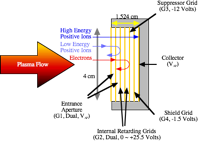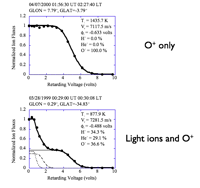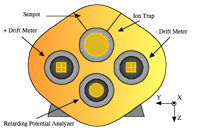ROCSAT-1/IPEI SDDC 中華衛星一號/電離層電漿電動儀科學資料分送中心
計畫主持人:蘇信一教授
(Operated during 1/1999 - 6/2004)
The IPEI instrument consists of an ion trap (IT) to collect ion fluxes, a pair of drift meters (VDM and HDM) to measure the arrival angle of the ion flow, and a RPA to obtain a current-voltage (I-V) curve to derive the ion temperature, ion composition and the ram flow velocity. Once the ram flow velocity is available, the cross-track ion velocities and ion concentration are obtained immediately.

The RPA consists of several metal grids to handle the incoming plasma. Dual aperture grids are arranged in the front of the sensor. The first aperture grid density is 50 lines/inch and the second one is 100 lines/inch. Both grids are connected to the senpot circuit and are maintained at floating potential to allow the incoming plasma smoothly into the RPA without affected by transverse electric field. Dual retarding grids are arranged after the aperture grids. The first retarding grid density is 100 lines/inch and the second one is 50 lines/inch. Both retarding grids are connected to a voltage sweeping circuit and form a potential barrier to block the low energy positive ions from going further into the RPA. The suppressor grid is arranged after the retarding grids and has a 50-lines/inch mesh. The suppressor is always maintained at -12 volts to repel incoming electrons from outside environment. At last, the shield grid with a 50-lines/inch mesh is maintained at -1.5 volts to block the photoelectrons struck out from the collector when the sun shines on the collector. The collector is a gold-plated metal surface and is also connected to the senpot circuit at the floating potential.

For a normal mode operation, the RPA can complete a 32-points retarding voltage sweep in a second. For a fast mode, the RPA can run a 64-points voltage sweep per second. As the retarding voltage increases, the positive ions with low kinetic energy will be repelled out of the sensor or absorbed by grids or interior boundary. The positive ions with high kinetic energy will go through the retarding grids to collector. Therefore the higher the retarding voltage, the lower the current is measured at collector. Such a sampling process can produce current-voltage (I-V) curves that are embedded with information on ion temperature, composition and ram velocity.






